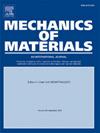Deformation and delamination of dynamically bulging bilayered films
IF 3.4
3区 材料科学
Q2 MATERIALS SCIENCE, MULTIDISCIPLINARY
引用次数: 0
Abstract
We employ finite element simulations to study the dynamic bulging of films under shock tube conditions and compare these responses with quasi-static bulging. Both scenarios subject the film to time-varying pressure. Two film types are considered: uniform material films and bilayers with a relatively soft interior layer and a hard exterior layer. The interface between the materials in the bilayer cases is modeled as a cohesive zone that follows a bilinear normal traction-separation cohesive law. Additionally, bilayer films with preexisting cracks in the interior layer are analyzed. Parametric studies are also conducted to explore the effects of loading rate and specimen size. The mechanical response of all materials is assumed to be strain-rate independent, focusing solely on the inertial effects in the response of the films under dynamic loading, and the absence of such effects under quasi-static loading. The results indicate that quasi-static bulging exhibits a predictable plate bending like deformation. In contrast, depending on the loading rate and specimen size, dynamic bulging can give rise to elastic waves, and a sequence of deformation processes including initial uniform acceleration, followed by bending-like deformation, and finally through-thickness biaxial stretching. Dynamic loading also leads to larger bulge formation and greater deformation than quasi-static loading. A key finding is the role of preexisting cracks in driving delamination under dynamic loading, which is absent in quasi-static loading. This work enhances our understanding of dynamic bulging and motivates further research on characterizing delamination in layered films using dynamic bulge tests.
动态鼓胀双层薄膜的变形和分层
我们采用有限元模拟来研究冲击管条件下薄膜的动态膨胀,并将这些反应与准静态膨胀进行比较。这两种情况都会使薄膜受到时变压力的影响。我们考虑了两种薄膜类型:材料均匀的薄膜和内层相对较软、外层较硬的双层薄膜。双层膜中材料之间的界面被模拟为内聚区,该内聚区遵循双线性法向牵引-分离内聚定律。此外,还分析了内层预先存在裂缝的双层薄膜。还进行了参数研究,以探索加载速率和试样尺寸的影响。所有材料的机械响应都假定与应变速率无关,只关注动态加载下薄膜响应中的惯性效应,以及准静态加载下的无惯性效应。结果表明,准静态鼓胀表现出类似板弯曲的可预测变形。相反,根据加载速率和试样尺寸的不同,动态隆起会产生弹性波和一系列变形过程,包括最初的均匀加速,然后是类似弯曲的变形,最后是贯穿厚度的双轴拉伸。与准静态加载相比,动态加载也会导致更大的隆起形成和更大的变形。一个关键的发现是,在动态加载下,预先存在的裂缝在驱动分层方面发挥了作用,而这在准静态加载中是不存在的。这项研究加深了我们对动态隆起的理解,并促使我们进一步研究如何利用动态隆起试验来表征层状薄膜中的分层。
本文章由计算机程序翻译,如有差异,请以英文原文为准。
求助全文
约1分钟内获得全文
求助全文
来源期刊

Mechanics of Materials
工程技术-材料科学:综合
CiteScore
7.60
自引率
5.10%
发文量
243
审稿时长
46 days
期刊介绍:
Mechanics of Materials is a forum for original scientific research on the flow, fracture, and general constitutive behavior of geophysical, geotechnical and technological materials, with balanced coverage of advanced technological and natural materials, with balanced coverage of theoretical, experimental, and field investigations. Of special concern are macroscopic predictions based on microscopic models, identification of microscopic structures from limited overall macroscopic data, experimental and field results that lead to fundamental understanding of the behavior of materials, and coordinated experimental and analytical investigations that culminate in theories with predictive quality.
 求助内容:
求助内容: 应助结果提醒方式:
应助结果提醒方式:


